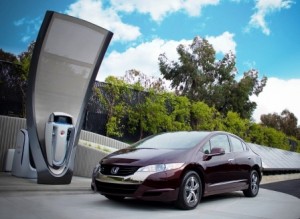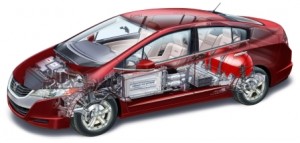Honda began operation today of a new solar hydrogen station prototype at its Los Angeles Research and Development Center. It is a prototype of a home refueling “appliance” capable of an overnight refill of a fuel cell electric vehicle.
The latest iteration reduces the size of the system, while producing enough hydrogen (0.5 kg) during an 8-hour overnight fill for daily commuting of as much as 10,000 miles per year for a fuel cell electric vehicle.
The Honda FCX Clarity electric vehicle is “fast fill capable” and offers an EPA-estimated driving range of 240 miles. One problem, among many, with hydrogen as a fuel is that it needs to be compressed at very high pressures in order for a vehicle to carry enough to have a usable range. However, hydrogen offers the tantalizing promise of being an emissions free fuel for vehicles.
The previous solar hydrogen station system required both an electrolyzer and a separate compressor unit to create high-pressure hydrogen. The compressor was the largest and most expensive component and reduced system efficiency.
Honda says its engineers have now created a new high differential pressure electrolyzer that eliminates the compressor.
This development also reduces the size of other key components to make the new station what Honda claims is the world’s most compact system, while improving system efficiency by more than 25% compared to the solar hydrogen station system it replaces.
The new Solar Hydrogen Station uses the same 48-panel, 6.0 kW solar array that powered the previous one. The array utilizes thin film solar cells composed of copper, indium, gallium and selenium (CIGS) produced by Honda Soltec Co., Inc., a wholly owned subsidiary of Honda that was established for the mass production and sales of solar cells capable of efficient renewable electricity generation.
The refueling appliance is compatible with a “Smart Grid” energy system, and would enable users to refill their vehicle overnight without the requirement of hydrogen storage, which in theory lowers CO2 emissions by using less expensive off-peak electrical power.
During daytime peak power times, the Solar Hydrogen Station can export renewable electricity to the grid, providing a cost benefit to the customer, while remaining energy neutral.
Honda claims it is simple to use and the user can easily lift and remove the fuel hose, with no “hose coiling” when the hose is returned to the dispenser unit.
As with the previous generation system, the hydrogen purity from the new station meets the highest SAE (J2719) and ISO (14687) specifications.



Okay, so “It is a prototype of a home refueling “appliance” capable of an *overnight refill* of a fuel cell electric vehicle.” And, it’s *solar powered*.
I don’t think the engineers connected all the dots…
Still laughing, and annoyed at myself that I missed the set-up for your joke – Ken Zino, editor…